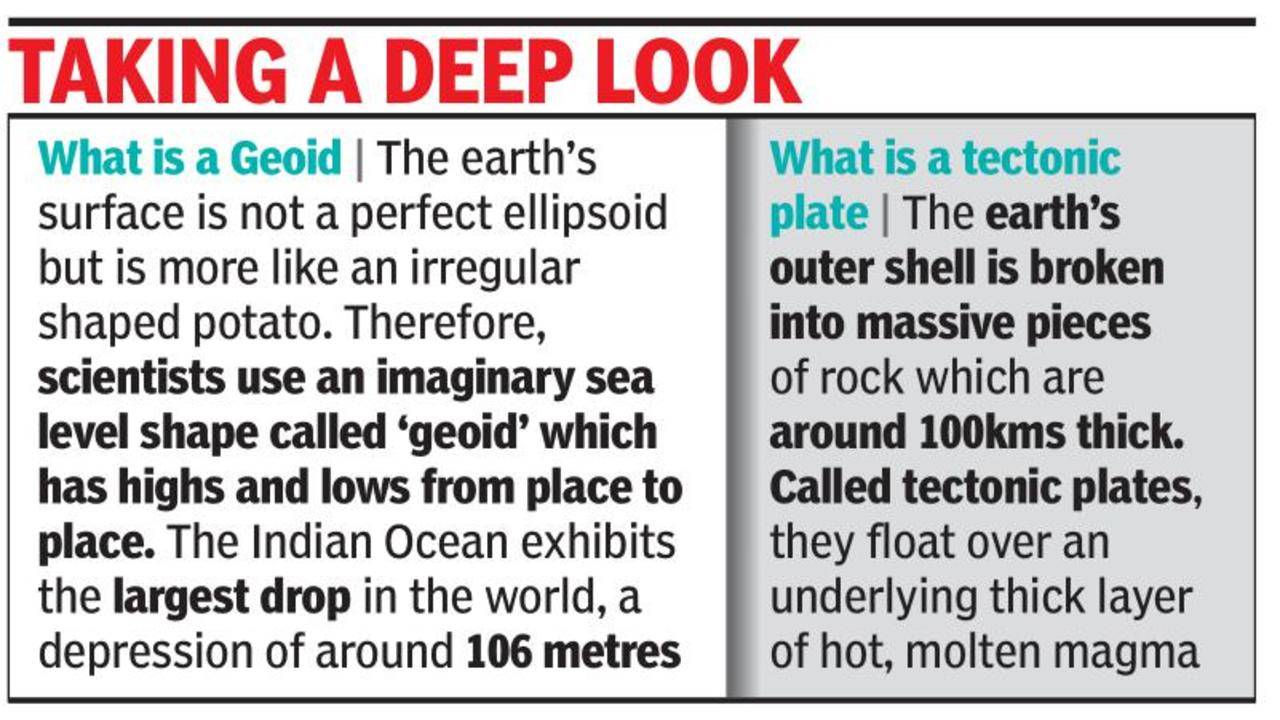Ahmedabad
(Head Office)Address : 506, 3rd EYE THREE (III), Opp. Induben Khakhrawala, Girish Cold Drink Cross Road, CG Road, Navrangpura, Ahmedabad, 380009.
Mobile : 8469231587 / 9586028957
Telephone : 079-40098991
E-mail: dics.upsc@gmail.com

Indian Ocean Geoid Low
News: Researchers at the Indian Institute of Science have revealed the secrets of the giant gravity hole that rests in the Indian Ocean.
What is Indian Ocean Geoid Low?
• The Indian Ocean Geoid Low (IOGL) is a giant ‘gravity hole’ in the Indian Ocean, where the gravity is lower than average and the sea level is 106 meters lower than the global average.
• It is the largest and deepest geoid anomaly on Earth, covering more than three million square kilometres.
• The IOGL is a result of a mass deficit inside the Earth’s mantle beneath the Indian Ocean, caused by the interaction of plumes and slabs. Plumes are hot, buoyant upwellings of mantle material that rise from the core-mantle boundary, while slabs are cold, dense downwellings of tectonic plates that sink into the mantle.
How did the scientists reveal the secrets? What went into the process?
• A study by Indian scientists, published in Geophysical Research Letters in 2023, showed that the IOGL was formed by plumes that originated from the edges of the African Large Low Shear Velocity Province (LLSVP), a massive thermochemical pile at the core-mantle boundary. These plumes were triggered by slabs from the Tethys Ocean, a long-lost sea that subducted under Africa and Eurasia millions of years ago.
• The study used global mantle convection models to reconstruct the plate tectonic movements and mantle dynamics since 140 million years ago, and showed that the IOGL took its present shape about 20 million years ago, when the plumes spread within the upper mantle.
• The study also explored various parameters that affect the shape and amplitude of the IOGL, such as the density and viscosity of the LLSVP, the Clapeyron slope and density jump at 660 km depth, and the strength of slabs.
How does IOGL affect ocean current?
• The IOGL affects ocean currents by creating a pressure gradient that drives the flow of water from high to low geoid regions.
• The IOGL also influences the thermohaline circulation, which is the global conveyor belt of ocean currents driven by differences in temperature and salinity.
• The IOGL may also have implications for climate change, as it modulates the heat and salt transport by ocean currents, which in turn affect the atmospheric circulation and precipitation patterns over the Indian Ocean region.

Address : 506, 3rd EYE THREE (III), Opp. Induben Khakhrawala, Girish Cold Drink Cross Road, CG Road, Navrangpura, Ahmedabad, 380009.
Mobile : 8469231587 / 9586028957
Telephone : 079-40098991
E-mail: dics.upsc@gmail.com
Address: A-306, The Landmark, Urjanagar-1, Opp. Spicy Street, Kudasan – Por Road, Kudasan, Gandhinagar – 382421
Mobile : 9723832444 / 9723932444
E-mail: dics.gnagar@gmail.com
Address: 2nd Floor, 9 Shivali Society, L&T Circle, opp. Ratri Bazar, Karelibaugh, Vadodara, 390018
Mobile : 9725692037 / 9725692054
E-mail: dics.vadodara@gmail.com
Address: 403, Raj Victoria, Opp. Pal Walkway, Near Galaxy Circle, Pal, Surat-394510
Mobile : 8401031583 / 8401031587
E-mail: dics.surat@gmail.com
Address: 303,305 K 158 Complex Above Magson, Sindhubhavan Road Ahmedabad-380059
Mobile : 9974751177 / 8469231587
E-mail: dicssbr@gmail.com
Address: 57/17, 2nd Floor, Old Rajinder Nagar Market, Bada Bazaar Marg, Delhi-60
Mobile : 9104830862 / 9104830865
E-mail: dics.newdelhi@gmail.com